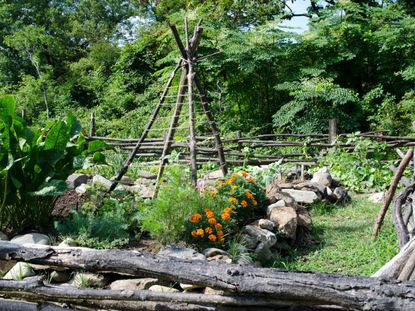Colonial Garden Plants: Tips For Growing And Designing Colonial Period Gardens

If you're looking for a garden that's practical as well as beautiful, consider growing a colonial kitchen garden. Everything within this type of old-style garden is deemed useful but is also pleasing to the eye. Designing colonial period gardens is both easy and rewarding. Keep reading to learn more about colonial gardens and how to create a colonial garden of your very own.
About Colonial Gardens
The colonial garden of yesteryear was a celebration of heritage as plants made their way from the “old world,” to the “new world.” Colonial gardens were made by very practical colonists and as a result were designed around needs rather than aesthetics, though these gardens were still truly beautiful. Square or raised bed gardens were popular and often placed in close proximity to the home to allow for easy access. In fact, many were located right outside the home kitchen. Live fences from hedges and shrubs or quaint pickets were used to protect gardens from wind and animals. Colonial kitchen gardens also included narrow rectangular beds full of medicinal and seasoning herbs. Herbs were frequently mixed in with fruits and vegetables. Fruit trees were used as focal points within the garden design too. All of these plants were commonly used for food preservation, healing and fabric dye.
How to Create a Colonial Garden
Designing colonial period gardens is popular amongst gardeners who want to preserve the heritage plants and the art of gardening. Learning how to create a colonial garden is simple. Raised narrow planting beds offer easy access and make an attractive colonial garden template. Fill beds with herbs, flowers and vegetables that can be used in the kitchen and around the house. Larger colonial garden designs may include walkways, benches, fountains and even a sundial. Colonial gardens often contained topiary plants as well, which can make a lovely addition to any landscape.
Colonial Garden Plants
An 18th century garden contained many beautiful heirloom flowers. Some of the most common of these colonial garden plants included:
Many heirloom vegetables were also used in the colonial kitchen garden. These included some of our most frequently grown vegetables today. Though these hybrid cousins bear little resemblance to the heirloom varieties, your own colonial garden plants in the vegetable patch can include:
Medicinal herbs in a colonial garden included horehound, a popular remedy for asthma and coughs, and Angelica, which was also used for colds and bronchial problems. Winter savory was often grown and used as an antiseptic and to relieve the pain of bee stings. Oregano was popular for toothaches and headaches. Other medicinal and cooking herbs included:
Gardening tips, videos, info and more delivered right to your inbox!
Sign up for the Gardening Know How newsletter today and receive a free download of our most popular eBook "How to Grow Delicious Tomatoes."
-
 Grow a Bathroom Oasis: 8 Best Bathroom Plants With No Light or Low Light
Grow a Bathroom Oasis: 8 Best Bathroom Plants With No Light or Low LightSome apartment dwellers grow the best bathroom plants with no light or low light. Read how one of our favorite plant lovers does it in the big city.
By Teo Spengler
-
 "My Worst Mistake" – Gardeners Share 10 Hard-Learned Lessons
"My Worst Mistake" – Gardeners Share 10 Hard-Learned LessonsGardeners never stop learning, and sometimes our mistakes are the best teachers. But why not save time and heartache by learning from other gardeners' failures?
By Melanie Griffiths